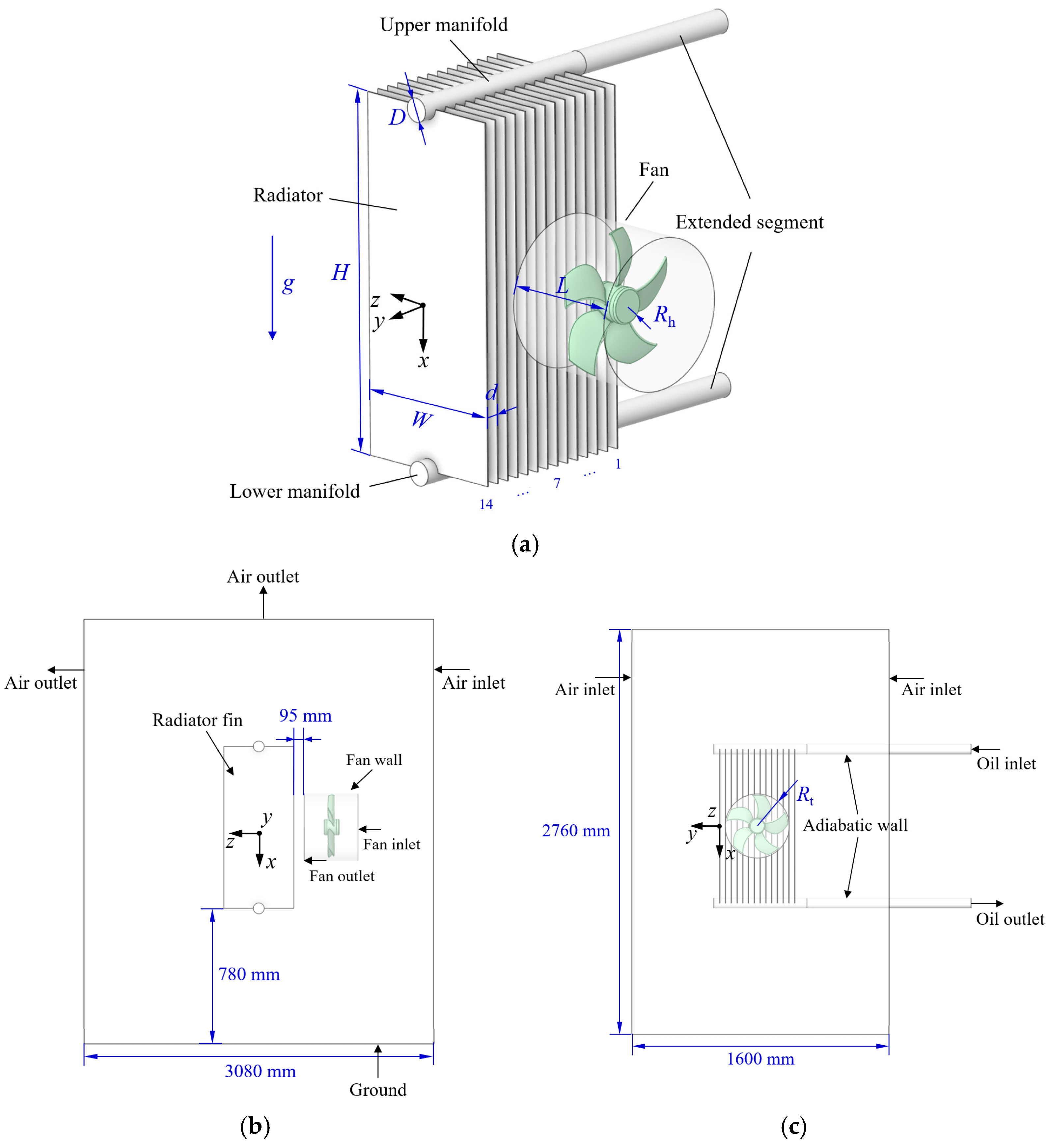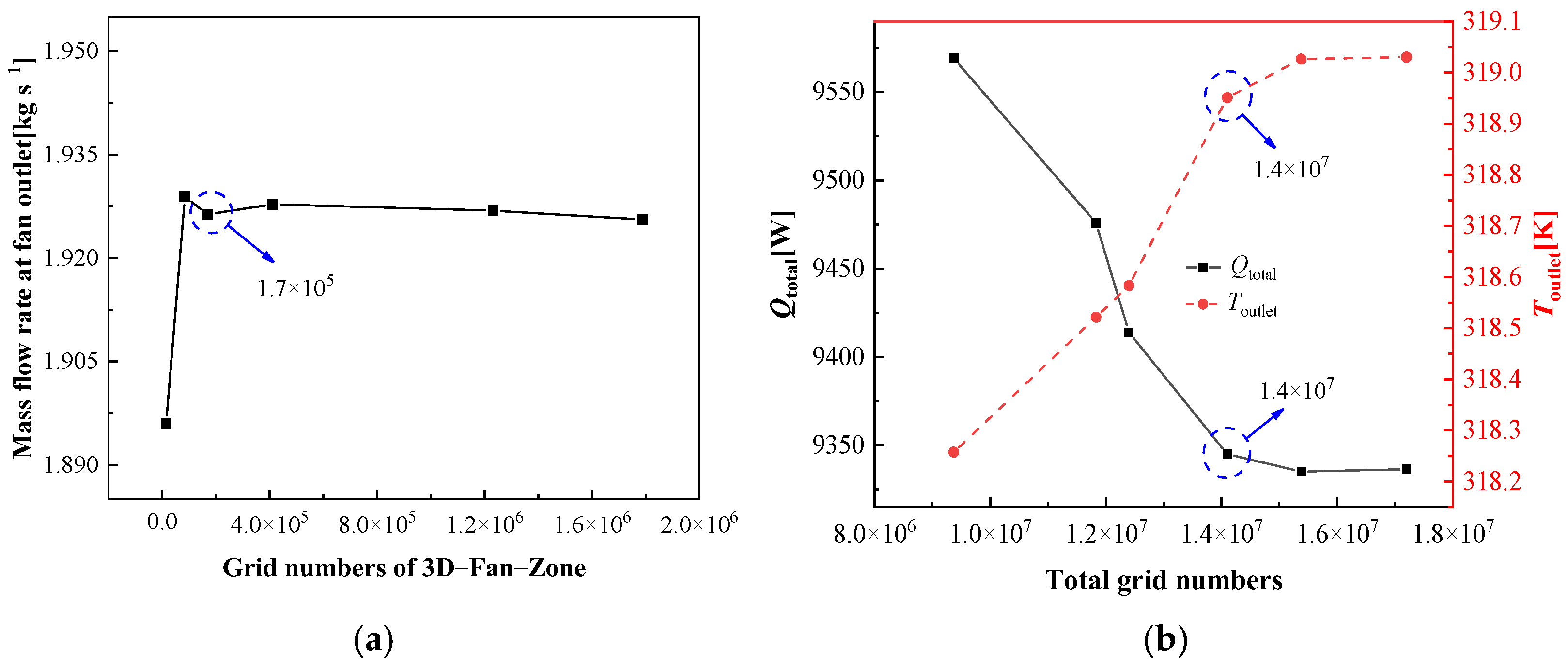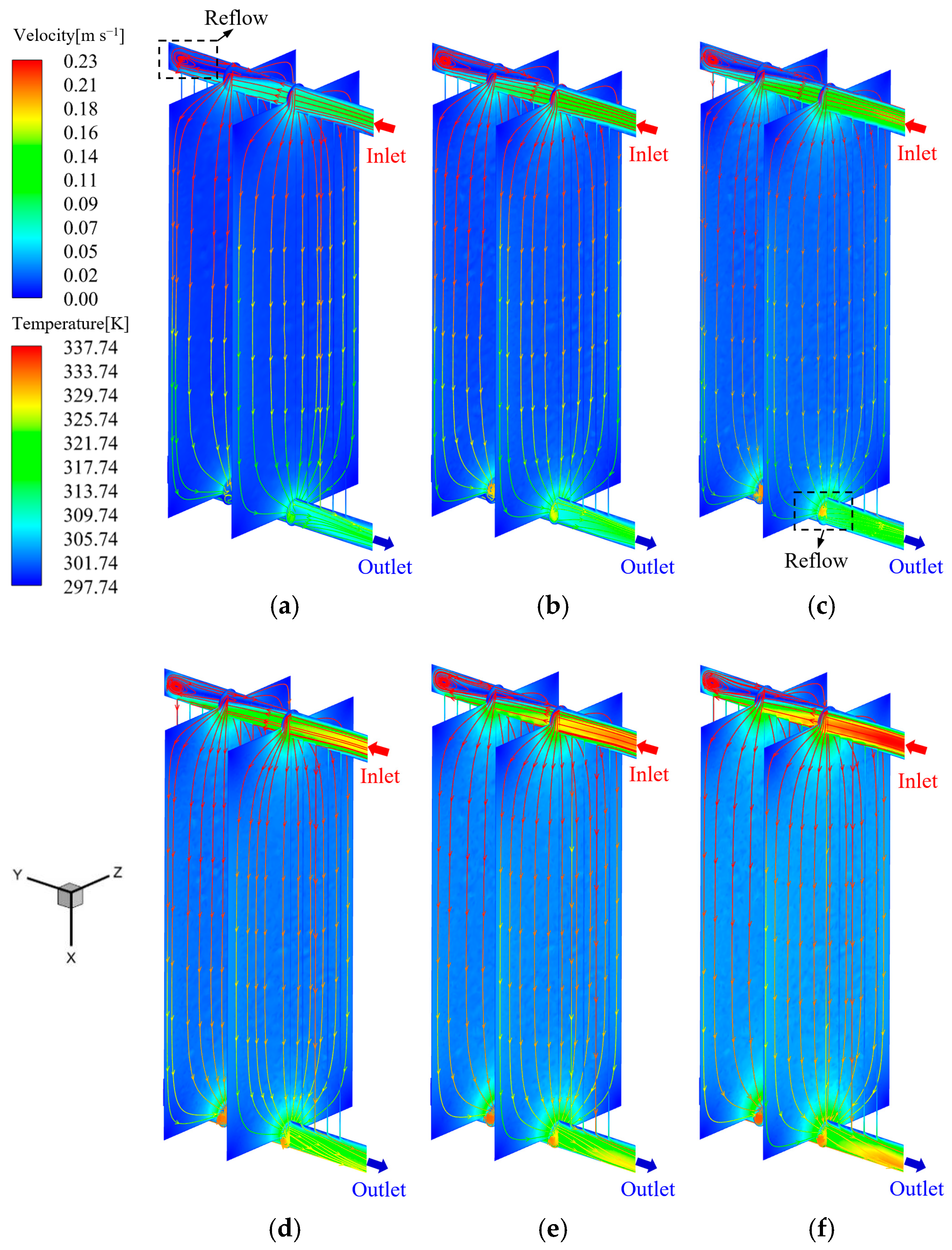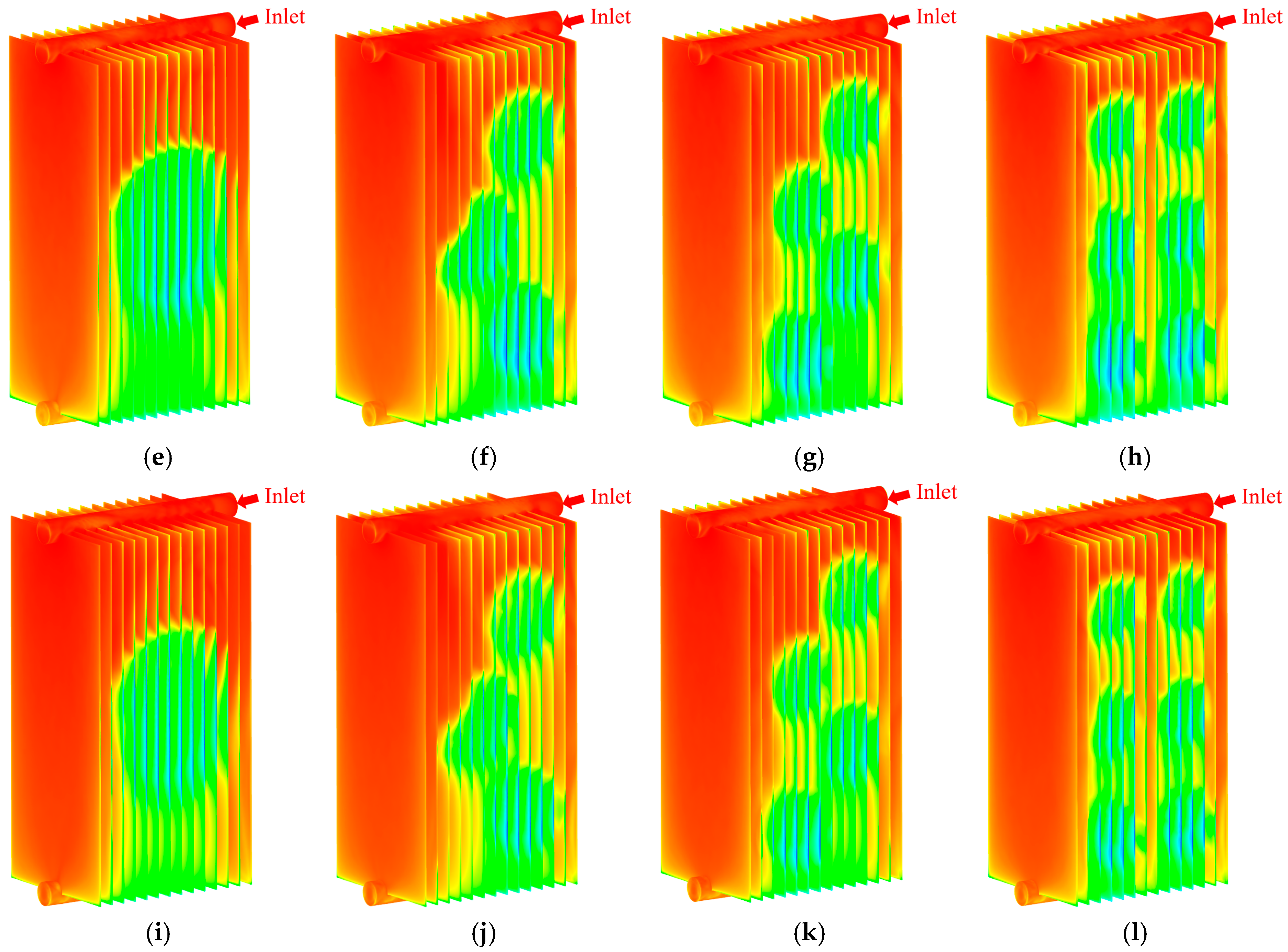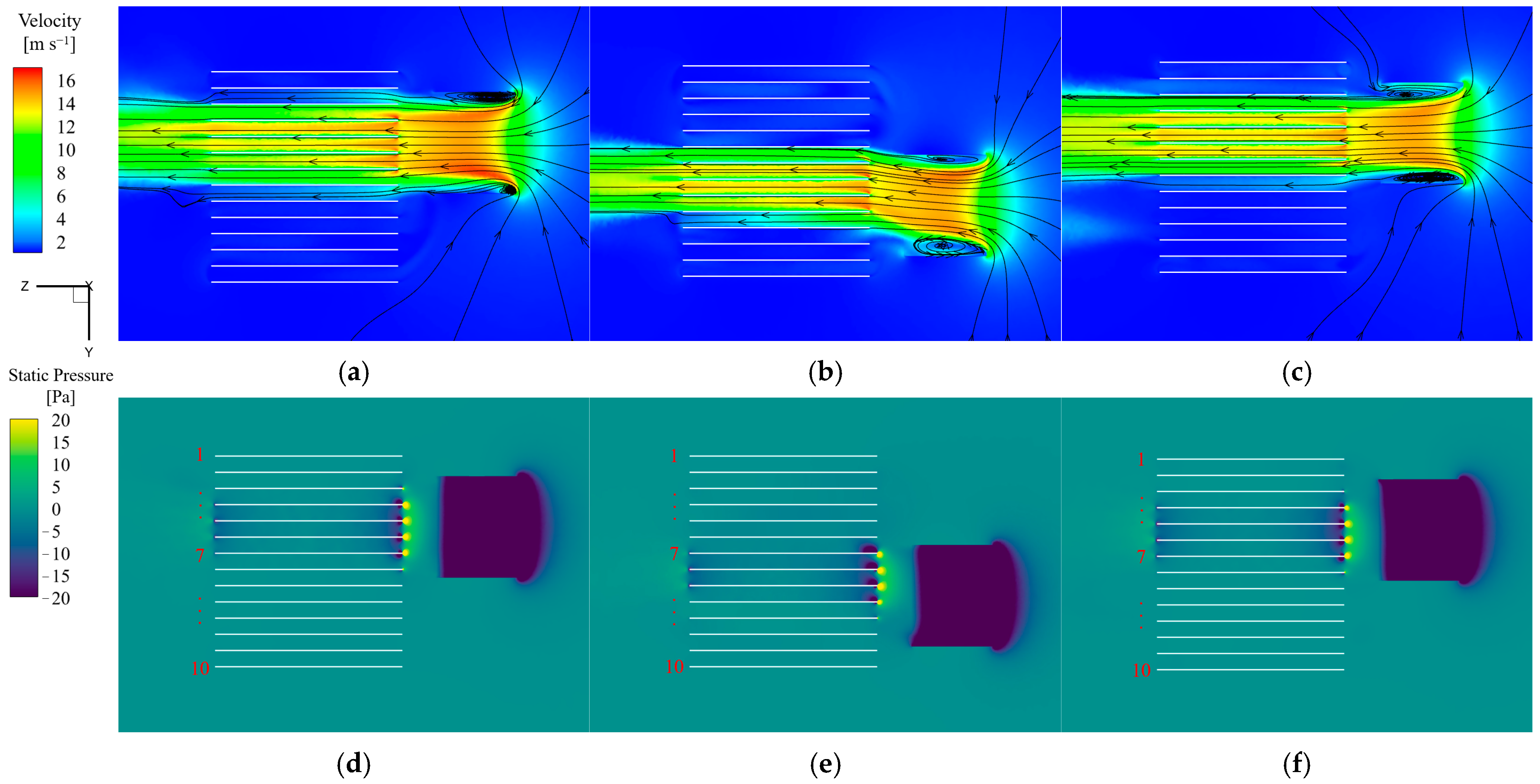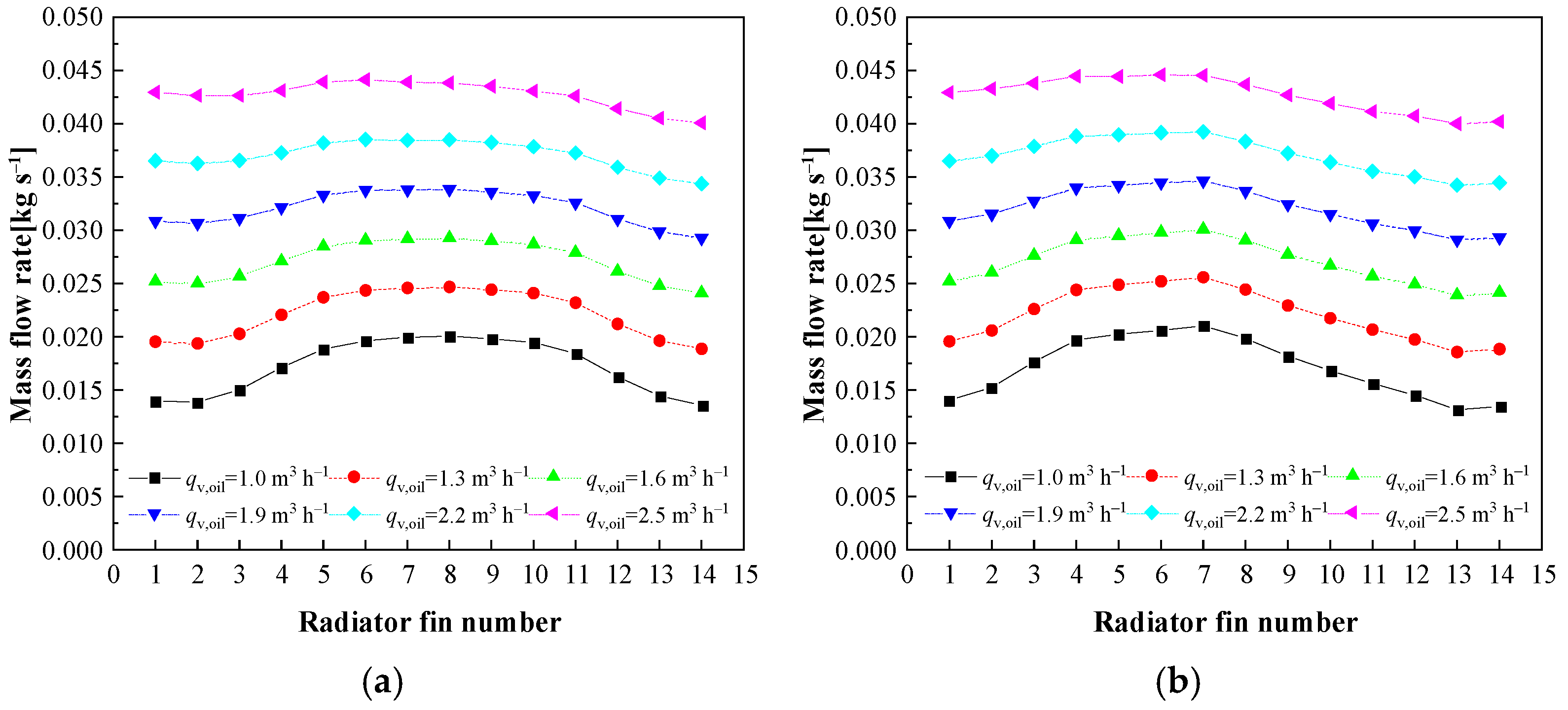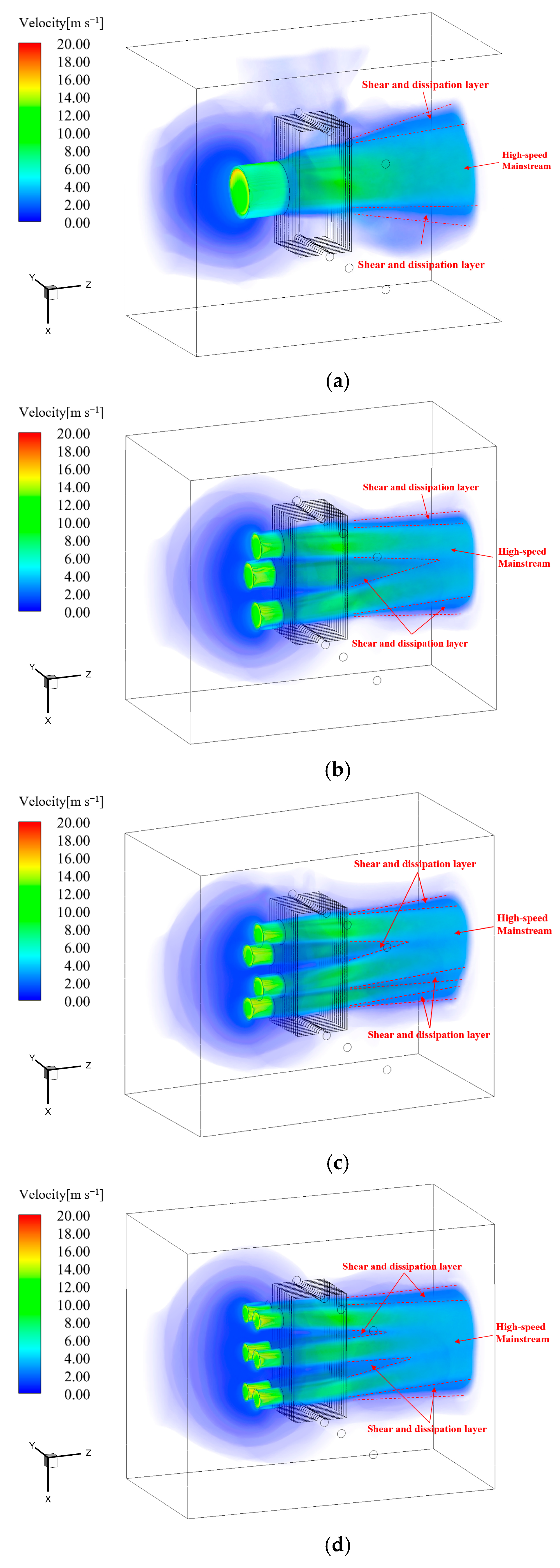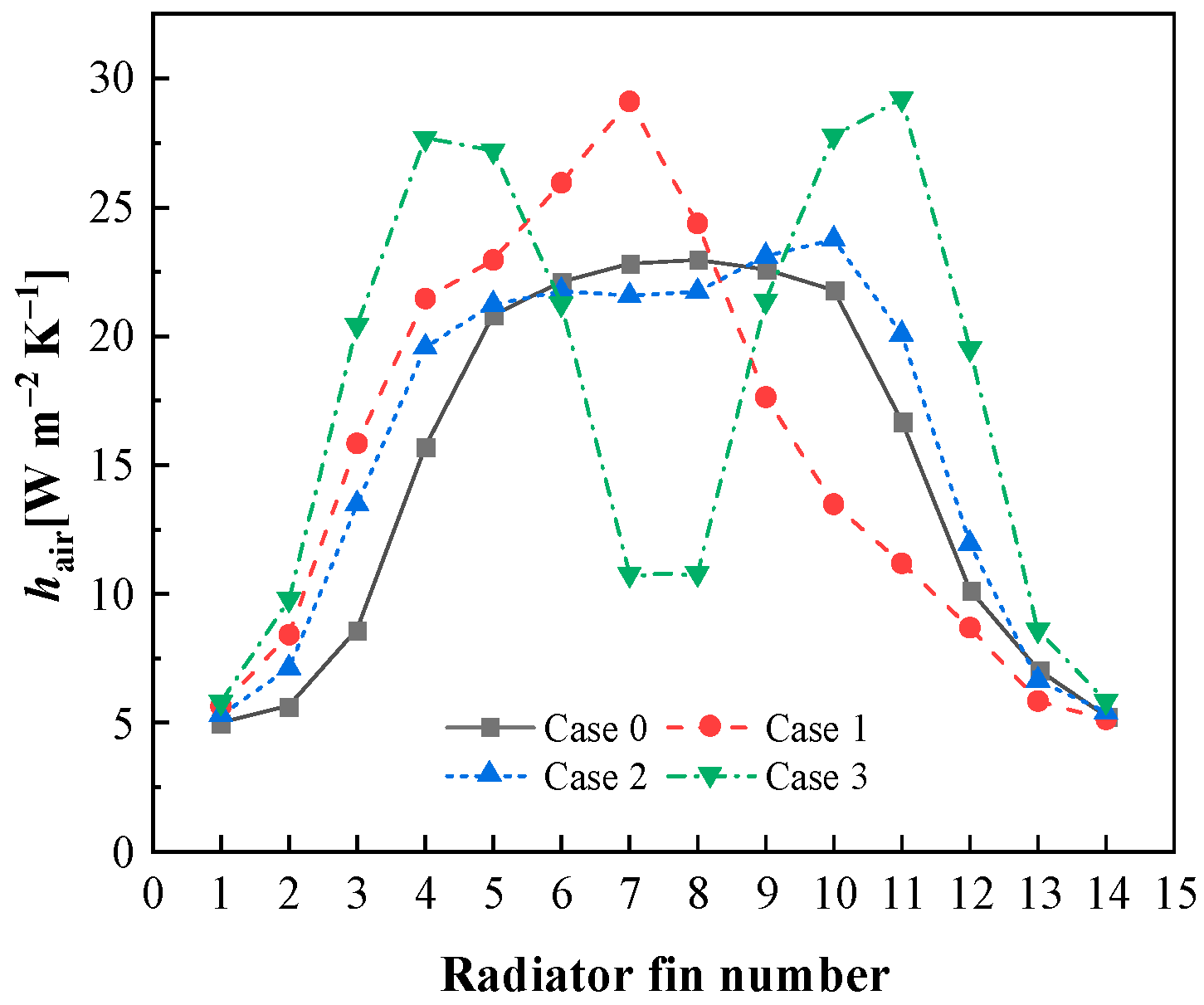5.1. Analysis of Flow and Heat Transfer of the Oil Inside the Panel-Type Radiator
In
Figure 7a–f, the velocity distribution and the streamline within the fifth and tenth fins of the panel-type radiator for different inlet oil flow rates (
qv,oil) in Case 1 are shown, where the color bands of the streamline diagrams represent the temperature variation of the insulating oil. Notably, the internal insulating oil flow is relatively insensitive to the different fan arrangements; hence, only the oil-side flow details for Case 1 are presented herein. As shown in
Figure 7a–f, it can be observed that the velocity boundary layer in the upper manifold is clearly visible at each inlet oil flow rate, and this characteristic is similar to the fully developed pipe flow of laminar flow in a circular tube [
36]. This phenomenon is mainly because of the larger dynamic viscosity of the insulating oil and the smaller flow rate (when the inner diameter of the manifold is chosen as the characteristic length, the insulating oil inlet
Re at different
qv,oil is
Re(
qv,oil = 1 m
3 h
−1) = 570.56,
Re(
qv,oi = 1.3 m
3 h
−1) = 741.73,
Re(
qv,oil = 1.6 m
3 h
−1) = 912.90,
Re(
qv,oi = 1.9 m
3 h
−1) = 1084.07,
Re(
qv,oil = 2.2 m
3 h
−1) = 1255.24 and
Re(
qv,oi = 2.5 m
3 h
−1) = 1426.41, separately, where
Re is defined in Equation (21)). As shown in
Figure 7a, when insulating oil flows through the connection between the manifold and the first radiator fin, part of the insulating oil flows to the radiator fin, which leads to the destruction of the local flow boundary layer on the inner surface of the manifold, and the rest of the insulating oil continues to flow along the upper manifold. As the insulating oil continues to flow through the remaining heat sink connections, driven by pump pressure and gravity, other insulating oil gradually flows into the radiator fin along the upper manifold. During this progress, the velocity of the oil flow in the upper manifold decreases, and the center of the high-speed region moves downwards. Until the insulating oil flows through the last fin, the remaining insulating oil produces a reflow at the end of the upper manifold. As the insulating oil flows sequentially in radiator fins through the convective heat transfer with the inner wall surface, heat conduction in the fin wall, and convective heat transfer from the outer wall surface to air, its temperature gradually reduces along the height of the radiator. Consequently, the density of the oil also gradually increases due to the inverse relationship between temperature and density. In addition, since the oil flow rate through the same section is constant, the oil flow rate in the lower manifold is significantly reduced compared to the upper one. Finally, when the insulating oil flows into the lower manifold from the radiator fin, the direction of the streamline changes, and the main flow of insulating oil strikes the bottom surface of the lower manifold, which also creates local reflow at each outlet of the fins (as shown in
Figure 7c). Comparing
Figure 7a–f, as the insulating oil flow rate increases, the velocities in the radiator fin, and the upper and lower manifolds increase, and the oil temperature distribution becomes more uniform.
where
ρ is the oil density at the inlet, kg m
−3;
u is the oil flow rate at the inlet, m s
−1;
D is the manifold diameter, m;
μ is the insulating oil dynamic viscosity, kg m
−1 s
−1.
Figure 8a–l show the temperature distribution on the outer wall surface of the radiator fin at different insulating oil flow rates (
qv,oil = 1.0 m
3 h
−1, 1.6 m
3 h
−1, 2.2 m
3 h
−1) for Cases 0–3, respectively. From these figures, it can be found that the wall temperature distributions of the first and fourteenth radiator fins for each case are similar to the wall temperature distributions in the literature [
37], which works in AN mode. This phenomenon can be attributed to the insufficient coverage of the airflow generated by the fan over the entire fin surface. Consequently, the airflow behavior near the initial and terminal fins approximates that of natural convection. Furthermore, localized low-temperature regions corresponding to the number and location of the fans can be observed under all cases in
Figure 8a–l. The tops of these regions are approximately circular in shape, and these regions gradually expand in the positive
x-direction of the fin. The aforementioned phenomenon is primarily attributed to the significant reduction in radiator wall temperature at the location directly blown by the fan, which indirectly leads to a decrease in the insulating oil temperature at that location. Furthermore, due to the
x-directional flow of the insulating oil, the insulating oil located downward of the low-temperature region absorbs heat from the radiator surface through convective heat transfer, resulting in a decrease in the wall temperature at the radiator surface. A comparison of
Figure 8a–d reveals that in Case 0, due to the largest local fan-blowing area, the enhanced heat dissipation region of the fan is more concentrated, resulting in the longest diffusion distance of its localized low-temperature region in the
x-direction. In Cases 1–3, as the blowing area of a single fan gradually decreases, the intensified heat dissipation area of the fan becomes more dispersed. Therefore, the diffusion distance of a single local low-temperature zone along the positive
x-axis gradually decreases. Meanwhile, due to the increase in fan numbers, the panel-type radiator transitions to zoned heat dissipation at this time. Comparing
Figure 8a,e,i,
Figure 8b,f,j,
Figure 8c,g,k, and
Figure 8d,h,l separately, it can be found that as the flow rate of the insulating oil gradually increases, the temperature difference between the inlet and outlet of the heat sink decreases. Moreover, under the same fan arrangement conditions, the diffusion distance of the local low-temperature zone gradually decreases. This is because, at a lower oil velocity, the higher-temperature insulating oil remains in the fan blowing area for a longer time, which allows for a more effective heat dissipation. As the oil flow rate increases, the insulating oil inside the radiator (especially the insulating oil near the leeward region) can not fully dissipate heat before flowing out of the fan coverage region. Subsequently, the lower-temperature insulating oil near the windward region mixes with the higher-temperature insulating oil near the leeward region, causing the wall temperature to rise again. Therefore, in
Figure 8, the local low-temperature zone can only diffuse within a limited distance because the insulating oil flowing through the fan coverage region does not have sufficient time to fully dissipate its heat before exiting the region. As the flow rate increases, the residence time of the insulating oil in the fan coverage region decreases, further reducing the diffusion distance.
Figure 9a–l show the distribution of the local convective heat transfer coefficient (
hl) on the outer wall surface of the radiator fin at different inlet insulating oil flow rates (
qv,oil = 1.0 m
3 h
−1, 1.6 m
3 h
−1, 2.2 m
3 h
−1) for Cases 0–3, respectively, where
hl can be defined in Equation (22). As shown in
Figure 9a–l, there is a local region with a high convective heat transfer coefficient on the windward region of the panel-type radiator that corresponds to the number and location of the fans. Since these regions are directly covered by horizontal blowing fans, it indicates that these side fans enhance heat dissipation in these regions. The area directly covered by the fan (at the lateral of the radiator) is subjected to jet impingement, and the boundary layer is obviously thinned, especially among these regions. Therefore, the local convective heat transfer coefficient at this location is significantly higher than in other surrounding regions. It is worth mentioning that the phenomenon of high heat dissipation performance zones diffusing along the positive
x-axis, as observed in
Figure 8, can not be observed in
Figure 9. This further demonstrates that the diffusion of local low-temperature zones in
Figure 8 is not caused by reasons such as the radial diffusion of high-velocity airflow. A comparison of
Figure 9a,e,i,
Figure 9b,f,j,
Figure 9c,g,k, and
Figure 9d,h,l reveals that the change in oil flow rate has a relatively small impact on the local convective heat transfer coefficient on the air side of the radiator.
Furthermore, it is observed that the uniformity of the local low-temperature zone and high heat dissipation performance zone formed by the left fan in
Figure 8b,f,j, and
Figure 9b,f,j is relatively poor. In order to further elucidate the unique temperature and local convective heat transfer coefficient distributions in Case 1,
Figure 10 shows the airflow velocity and static pressure distributions at different
yz planes (
x = −0.335 m, 0 m, and 0.335 m). As shown in
Figure 10a,c, the high-velocity airflow generated by the first and third fans from top to bottom exhibits good symmetry, with the high-velocity main flow zone exhibiting only a minor offset toward the positive
y-axis direction at the center. However, in
Figure 10b, it is observed that the high-velocity main flow zone of the second fan occurred a significant offset toward the negative
y-axis direction relative to its center position. Assuming negligible resistance losses, the sum of dynamic pressure and static pressure along the airflow direction remains constant, according to Bernoulli’s equation; hence, regions with higher flow velocity exhibit lower static pressure. In Case 1, the average velocity is higher and the static pressure is lower at the first and third fans’ locations due to the uneven arrangement of fans. This static pressure difference leads to the main airflow at the outlet of the second fan skewing toward the first and third fans. Correspondingly, in
Figure 10e, it is also observed that the static pressure of the airflow to the right of the seventh to eleventh fins gradually decreases. Conversely, it can be found in
Figure 10d,f that there is no significant gradient change in static pressure in the air domain between radiator fins.
where
ql is the local heat flux rate per unit area, W m
−2;
Tw is the local wall temperature of the radiator fin, K; and
Tair,∞ is the ambient temperature, K.
Figure 11a–d illustrate the mass flow rate distribution of the insulating oil within the first to fourteenth radiator fins in different cases (Cases 0–3). For Case 0 (single-fan horizontal blow) in
Figure 11a, the insulating oil flow rate within different radiator fins is higher in the middle and lower on both sides over these curves, and the oil flow rate within the fins with smaller numbers is slightly higher than that within the fins with larger numbers. The above phenomenon is due to the fact that in Case 0, the fan is arranged in the center, and the fan mainly covers the third to twelfth fins. Moreover, the fan blowing area gradually decreases as it approaches the sides, and the heat dissipation capacity gradually weakens. Better heat dissipation performance is conducive to reducing the oil temperature inside the radiator panel, thereby increasing the thermosiphon pressure and consequently increasing the oil flow rate of the radiator fins in the middle area [
8]. It can also be observed from
Figure 11a that the oil flow rate of the fins near the inlet of the manifold (fins 1–7) is slightly higher than that at the other end (fins 8–14). On the one hand, the flow path of the radiator fins near the oil inlet is shorter, the flow resistance is smaller, and the oil flow rate is larger. On the other hand, the fins near the oil inlet are closer to the oil inlet of the upper manifold, the average oil temperature is higher, the total heat dissipation is greater, and the thermosiphon effect is stronger. With the increase in
qv,oil, it is observed that the percentage of the oil flow rate inside fins covered by the fan (fins 3–12) decreases. This is because as the
qv,oil increases, the pump pressure increases, and the influence of the thermosiphon pressure decreases. Therefore, the oil flow rate distribution within different fins tends to be uniform. In
Figure 11b–d, the oil flow rate distribution under different conditions (Cases 1–3) shows significant differences compared to Case 0. In Case 1 (3-fan horizontal blow), due to the non-uniform fan arrangement (two of the fans are located on the side of fins 3–7), these fins have better heat dissipation performance and a larger percentage of oil flow rate distribution. The other fan is mainly located on the side of fins 7–12, so the flow rate of fins 8–12 is higher than that of natural convection but lower than that of fins 3–7, which are directly blown by two fans. Specifically, according to
Figure 9b,f,j, the seventh fin is the shared influence area of three fans, so it has the best heat dissipation performance and the largest oil flow rate. As shown in
Figure 11c, for Case 2 (4-fan horizontal blow), it can be found that the oil flow rate distribution curves have two local maximum values, with the left local maximum value larger. According to
Figure 9c,g,k, on the one hand, the two fans near the oil inlet are located at a higher position, where the insulating oil at this position has a larger temperature difference with the environment, resulting in stronger heat dissipation. On the other hand, the fins with smaller serial numbers are closer to the oil inlet of the manifold, which also leads to enhanced heat dissipation performance. Finally, in
Figure 11d, the oil flow rate distribution curves have two highly symmetrical bulges, which are caused by the uniform arrangement of the six fans in Case 3. This also indicates that the asymmetry of the two bulges in Case 2 is mainly caused by the asymmetric arrangement of the fans.
5.2. Analysis of Flow and Heat Transfer of the Air Outside the Panel-Type Radiator
Since different oil-side flow rates have relatively small impacts on the distribution of the air, the operating conditions with oil flow rates of
qv,oil = 1.0 m
3 h
−1 are mainly analyzed and explained in this section.
Figure 12a–d show the velocity distribution of the air domain for Cases 0–3 with an oil flow rate of
qv,oil = 1.0 m
3 h
−1, respectively. In
Figure 12a (Case 0), the fan sucks in cool airflow from the back and blows it toward the panel-type radiator, which then flows through the air channel between radiator fins and is subsequently discharged from the other side of the panel-type radiator. When the high-speed airflow flows from the fan outlet, on the one hand, it is subjected to viscous forces, and on the other hand, there is a velocity gradient between the high-speed airflow in the central region and the stationary air in the far field. Therefore, a shear dissipation layer is formed at the edge of the high-speed airflow while the airflow in the central region continues to flow along the main flow direction. This also causes the high-speed mainstream region to gradually spread out along the radial direction to form a bell-mouth shape, and the air velocity along the mainstream direction gradually decreases. As shown in
Figure 12b–d, the high-speed airflow generated by each fan displays similar flow characteristics before merging with the cooling fins’ air channels under the three multi-fan arrangements. Compared with Case 0 in
Figure 12a, the fan influence region is significantly expanded due to the adoption of multi-fan arrangements in Cases 1–3. Additionally, the phenomenon of intermixing of the air shear dissipation layers between close fans can be observed in all three cases, which can facilitate the integration of high-speed mainstream regions and induce the high-speed fluid to converge in the main flow direction. This mutually offsetting energy dissipation in the shear and dissipation layers of different fans helps reduce fan losses, thereby increasing fan performance [
38].
As shown in
Figure 13a–d, Different temperature distributions on the velocity iso-surfaces corresponding to the velocity values of 4 m s
−1 in different cases (
qv,oil = 1.0 m
3 h
−1) are given. It can be clearly found that the air blown by the fans exchange heat with the surface of the radiator fins as it passes through the airflow channel between the fins, resulting in a gradual increase in air temperature. Subsequently, when the air flows out of the channel between the fins, the air temperature gradually decreases and eventually approaches the ambient temperature. Furthermore, it can be observed in
Figure 13b–d that the high-speed airflow generated by different fans merges downstream of the main flow, which is consistent with the phenomenon of intermixing of air shear dissipation layers in
Figure 12b–d. Finally, a stagnation area along the inner wall of the fans can be observed in
Figure 13a–d. This is because of the acceleration of air inside the fans, which, in order to keep a constant mass flow rate, leads to the formation of a local negative pressure region near the fan wall where the shear stress is high.
Figure 14a,b present the numbering method of airflow channels and the average outlet air velocity (
vair) for different airflow channel numbers in Cases 0–3, respectively.
Figure 15 shows the average convection heat transfer coefficients (
hair) on the air side of the radiator fins numbered 1–14 in Cases 0–3. As can be seen in
Figure 14b, in Case 0 (a single fan horizontal blowing), the airflow generated by the fan mainly flows in airflow channels 3–11. Therefore, the cooling speed of the transformer oil in the corresponding fins is faster in the direct fan blowing region (see
Figure 8a,e,i). Accordingly, the
hair of radiator fins 3–12 is relatively high in
Figure 15, among which the
hair of the third and twelfth radiator fins is slightly higher than that of radiator fins not in the direct fan blowing region (radiator fins 1, 2, 13, and 14) because a half of wall surface of these two fins are located in the direct fan blowing region. When the fan arrangement adopts horizontal blowing with three fans (Case 1), as can be seen in
Figure 1b, two of the fans are arranged between the second and eighth airflow channels, while the other fan is arranged between the sixth and twelfth airflow channels. Therefore, in
Figure 14b, airflow channels 2–11 have a higher average outlet air velocity, while the twelfth airflow channel has a relatively lower air velocity because it can only be blown by the outermost part of a single fan. Because of a larger blowing area near the manifold inlet and outlet, the
vair and
hair curves shift to the left compared with Case 0. In addition, since the three fans in Case 1 have a larger blowing area for the sixth and seventh airflow channels, then it can be found in
Figure 15 that the seventh radiator fin, which is located between the two airflow channels, has the highest
hair. As shown in
Figure 14b, when the fan arrangement is the horizontal blow with four fans (Case 2), the local maximum values of the average outlet air velocity (
vair) at airflow channels 5 and 9 are reached, respectively. As can be seen in
Figure 1c, this is because the above two airflow channels are both located in the maximum blowing area of two fans. Additionally, The seventh airflow channel in
Figure 14b is the overlapping airflow area of the four fans, but it can be found that the
vair of airflow channel 7 is the minimum. This is because this airflow channel is located near the four-fan walls, whose effective blowing area is small. Due to the presence of a flow stagnation area between the fan blade tips and the fan inner wall, as illustrated in
Figure 13a–d, the airflow velocity is further reduced. It is noteworthy that in
Figure 15, the average heat transfer coefficients (
hair) of the fins adjacent to the seventh airflow channel (the seventh and eighth fins) are not significantly lower than those of the other fins. On the one hand, the heat dissipation performance of the seventh and eighth fins is influenced not only by the air velocity within the seventh airflow channel but also by the sixth and eighth channels, which have higher air velocities. On the other hand, although the average air velocity in the seventh airflow channel is relatively low, as observed in
Figure 9c,g,k, in Case 2, the airflow from the fan has a broader range of influence along the
x-direction, which is beneficial for enhancing the average heat transfer coefficients of the seventh and eighth fins. As shown in
Figure 14b, when the fan arrangement is horizontal, blowing with six fans (Case 3), the trend of
vair curves is similar to that in Case 2. It also can be found that the local maximum values of
vair are located in the fourth and tenth airflow channels. As indicated in
Figure 1d, these channels correspond to the largest blowing areas of the three fans. Consequently, the fins near these channels (radiator fins 4, 5, 10, and 11) exhibit better heat dissipation performance with relatively high
hair. Conversely, the local minimum value is at the outlet of the seventh airflow channel, which lacks direct blowing and thus has the lowest air velocity. As a result, the fins near this channel (the seventh and eighth fins) demonstrate poorer heat dissipation performance, with lower
hair.
5.3. Analysis of Overall Heat Transfer Performance for Panel-Type Radiator
As presented in
Figure 16, a comparison between the experimental and numerical results for the overall heat transfer coefficient (
k) of the panel-type radiator under different inlet oil flow rates in Cases 0–3 is given. In this figure, the experimental results consistently exceed the numerical simulation results for the same operating conditions. This discrepancy can be attributed, on the one hand, to the simplification in the numerical simulation, where the radiator fins with multiple oil flow channels are modeled as thin rectangular solids, failing to fully capture the detailed flow and heat transfer characteristics inside and outside the fins. On the other hand, a steady-state numerical model for simulating the fan flow is used in this study; it also introduces some computational deviation. Overall, the maximum relative deviation (
δmax) and the average relative deviation (
δave) between numerical simulation and experiment that can be calculated from Equations (23) and (24) are 13.43% and 10.68%, respectively. This indicates that the simplified numerical method for the air-cooled panel-type radiator proposed in this study maintains a high level of accuracy and preserves a significant amount of local flow and heat transfer details. Furthermore, compared to [
8], this study achieves an average reduction in computation time of approximately 90% on a workstation with a lower clock speed and the same number of parallel processors.
where θ is the cases at six different
qv,oil, the subscripts sim and exp denote the simulation and experimental results, respectively.
In
Figure 16, all of the three multi-fan blows (Cases 1–3) enhance the heat dissipation performance of the panel-type radiator to varying degrees. In the traditional horizontal blow (Case 0), a single fan primarily provides effective cooling to the central section of the fins, while the fins on both ends are nearly subject to natural convection. With the adoption of the multi-fan horizontal blowing method, although the total blowing area is approximately equal, the airflow distribution becomes more uniform. Additionally, the proportion of airflow directed toward the high-temperature region near the header of the fins increases, resulting in improved overall cooling efficiency. According to the experimental results, compared with Case 0, the three multi-fan horizontal blowing methods (Cases 1–3) can improve the overall heat transfer coefficient of the panel-type radiator by up to 3.95%, 7.17%, and 10.42%, respectively; according to the numerical simulation results, the three multi-fan horizontal blowing methods (Cases 1–3) can improve the overall heat transfer coefficient of the panel-type radiator by up to 2.83%, 5.21%, and 15.44%, respectively. In addition, as the oil flow rate increases, the overall heat transfer coefficient of the radiator gradually increases under each fan arrangement. From the previous analysis, on the one hand, this is because the acceleration of the oil flow can effectively reduce the oil-side boundary layer and improve the oil-side convection heat transfer coefficient; on the other hand, it can be known in
Figure 8 that the increase in oil flow rate can reduce the oil temperature difference between the inlet and outlet of the radiator, making the average wall temperature of the radiator higher and the distribution more uniform. Since the air-side flow of the radiator is mixed convection, the local natural convection heat dissipation performance can be augmented with the increase in the average wall temperature.
As shown in
Figure 16, both the numerical simulation and experiment show that the multi-fan arrangement has a more significant heat transfer enhancement effect at a lower oil flow rate. With the increase in transformer oil flow rate, the heat transfer enhancement effect gradually weakens. This is because the uniformity of the heat sink wall temperature increases with the increase in oil flow rate, and the smaller the benefit of using multiple fans to dissipate heat for the high-temperature area of the radiator. It is foreseeable that as the oil flow rate further increases, the overall temperature of the radiator will tend to become uniform. Under the condition of a constant total blowing area, the enhanced heat transfer effect achieved by the multiple fans will gradually decrease. Therefore, it can be inferred that this method may have a better heat dissipation enhancement effect for panel-type radiators in ON mode with slower oil flow rates. As compared with the minimum oil flow rate (
qv,oil = 1 m
3 h
−1), in the experiment, with the increase in oil flow rate, the four blowing methods (Cases 0–3) can improve the overall heat transfer coefficient by up to 11.22%, 8.76%, 6.81%, and 5.41%, respectively; in the numerical simulation, the four blowing methods (Cases 0–3) can improve the overall heat transfer coefficient by up to 7.88%, 7.85%, 7.72%, and 3.91%, respectively.

